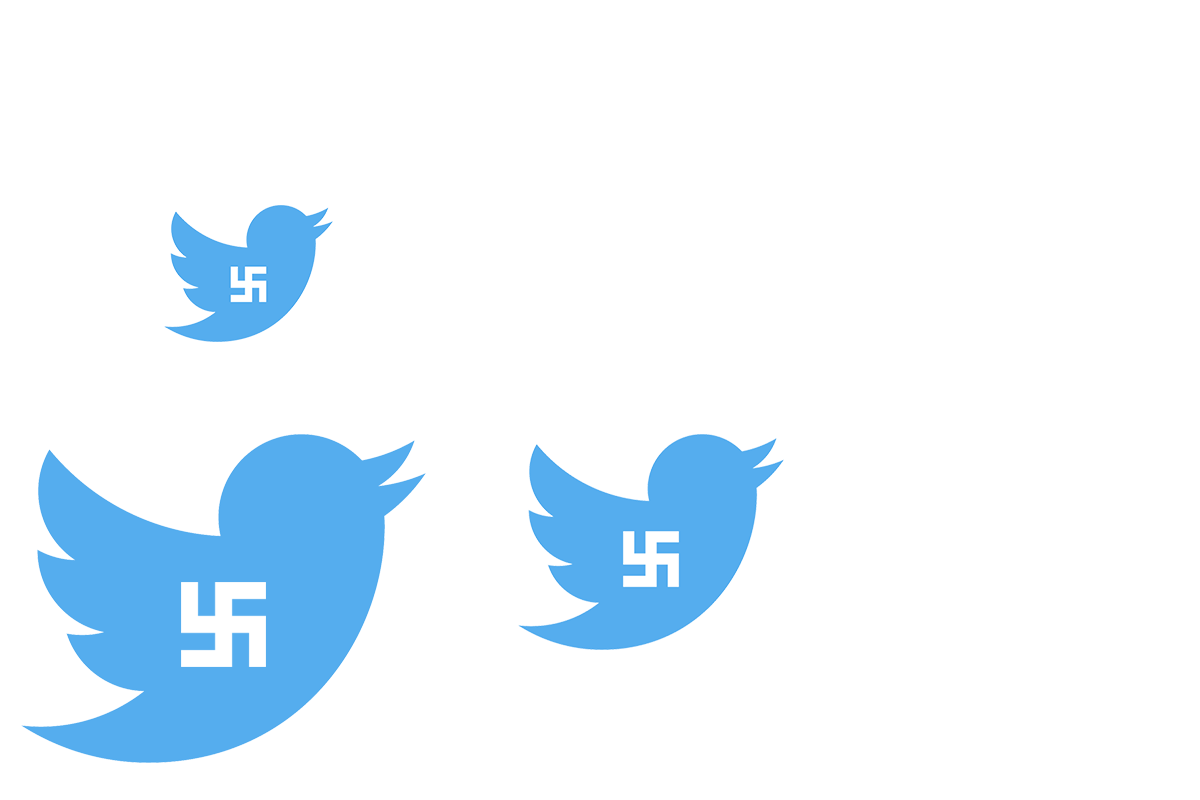This weekend, a horrific tragedy rocked America: A white nationalist entered a synagogue in Pittsburgh on Shabbat and murdered 11 Jews. While we’re still processing the horror, we’re looking for tangible ways to channel our anger and grief.
One way: Let’s hold Twitter, and other mainstream social media platforms, accountable for the widespread hatred on their platform.
(Note: The Pittsburgh synagogue shooter, a 46-year-old anti-Semite, was not on Twitter, but Gab. Gab — a site that has since been taken down — has been called a “haven for white nationalists.”)
So what is the platform doing about their Nazi problem? Monday morning, two days after Pittsburgh, Twitter announced they are removing the “like” button to “encourage debate.” First of all: why?! Everyone uses their likes. I have 7,000+ likes on Twitter, mainly for reference, to go back to, or to “like” something I don’t necessarily want to re-tweet.
Second of all, Twitter, you don’t need to “encourage debate.” You need to fucking ban the Nazis.
Many Twitter users agree:
Everyone: Hey Twitter, can you get rid of all the Nazis on here?
Twitter: Well no, but they won’t be able to like your tweets anymore.
Everyone: …
Twitter to remove 'like' tool in a bid to improve the quality of debate https://t.co/NHjhVPntwP via @telegraphtech
— Imani Gandy (Orca’s Version)
(@AngryBlackLady) October 29, 2018
Us: Please get rid of the Nazis
Twitter: What’s that, verify them?
Us: Please get rid of the Nazis
Twitter: We year you! Now you can tweet twice as long!
Us: Please get rid of the Nazis
Twitter: We know! We’re removing the “like” function. That’ll fix it!
— jordan (@JordanUhl) October 29, 2018
Twitter has had an anti-Semitism problem for a while now. Reporting Nazis on the platform doesn’t seem to do much. For example, Rochelle Ritchie, a political commentator, reported Cesar Sayoc (the “MAGABomber”) to Twitter for making death threats against her. The response Twitter gave her? “We have reviewed your report carefully and found there was no violation of the Twitter Rules against abusive behavior.”
Seriously. Click through these threats and tell us this isn’t abusive behavior:
https://twitter.com/RochelleRitchie/status/1055867631461416962
Twitter — after Sayoc’s arrest – apologized. This rang hollow for many.
At some point this is just empty rhetoric. People have been flagging threats on your service for at least more than half your actual existence. You don't care. You never have. cc @jack https://t.co/zVTvaje8mp
— Rachel Sklar (she/her) (@rachelsklar) October 27, 2018
https://twitter.com/alicialutes/status/1056265762124398592
(Honestly, there are so many tweets. So many angry tweets.)
In a TechCrunch article last month on Twitter’s Nazi problem, Josh Constine writes, “To avoid being labeled overly liberal which could lead to a flight of conservative users, Twitter has bowed to the abusers and weakly enforced its own rules. And since these trolls can be highly engaged with Twitter, they can rack up lots of ad views. [Twitter CEO Jack] Dorsey’s statement is emblematic of that stance, prioritizing user count, share price, and revenue over safety and civility.” Any attempts to crack down on hate speech and Nazis has largely failed.
As the Southern Poverty Law Center pointed out, the Pittsburgh synagogue shooter was radicalized online — largely on social media where “avenues to white supremacist radicalization remain largely wide open.” Social media is where conspiracy theories about George Soros spread rapidly, where neo-Nazis can organize a march in Charlottesville (yes, it was planned using a Facebook event), and men like “MAGAbomber” Cesar Sayoc become radicalized.
Political scientist Richard Hasen explained last year, “Social media has lowered the collective-action problems that individuals who might want to be in a hate group would face. You can see that there are people out there like you. That’s the dark side of social media.” The Pittsburgh synagogue shooter found a community of anti-Semites, where his messages about HIAS (the Hebrew Immigrant Aid Society) and hatred of Jews found a similar worldview.
In an article following the election in Brazil of far-right evangelical Jair Bolsonaro, writer Ryan Broderick lays out how social media has fundamentally altered “every major democracy on Earth.” Broderick explains how “far-right influencers… use Facebook, Twitter, and YouTube to transmit and amplify content and organize harassment and intimidation campaigns.” He shows how this happens in communities worldwide, not just America.
Why does it feel like Twitter (and Facebook and Instagram and other platforms) aren’t doing anything? As writer Sarah Weinman tweeted nearly two years ago, “One day Twitter will finally acknowledge what we’ve all known for years: they can’t ban abusive trolls because they keep the service afloat.”
For example, writer Talia Lavin, who has been outspoken about her Jewish identity and the harassment she’s faced on Twitter, shared a thread of the abuse she gets daily.
this isn’t about me. it’s an illustration if what i see every day. the hatred of jews is intertwined with hatred of the media. of “globalists,” a code word for jews. of “soros,” whose name is used as code. but we are not nebulous and scheming. we are human and scared.
— . (@swordsjew) October 27, 2018
We are human. And we are scared.
Let’s end with this:
Say it with me: companies don't owe you free speech. If you wanted to spew anti-Semitism or threaten someone in a Nordstrom, you'd be booted out immediately. Tech
companies
should
be
no different
. For as long as they are, they're complicit in this hate & violence.
— Shannon Coulter (@shannoncoulter) October 28, 2018
Twitter, you’re complicit. Do something.



